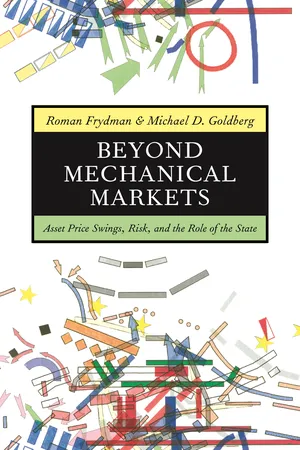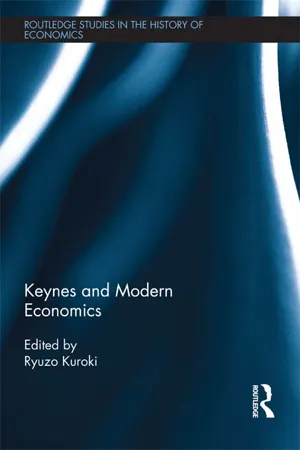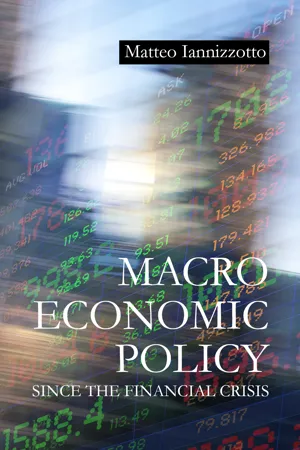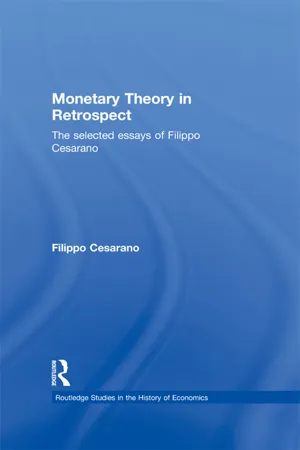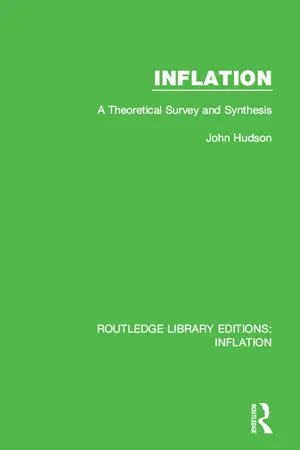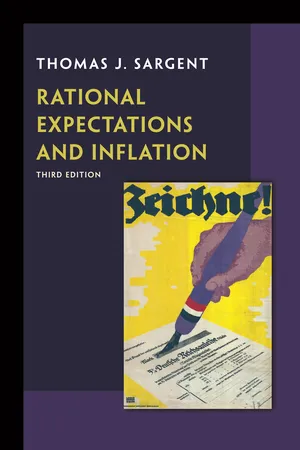Economics
Rational Expectations
Rational expectations is an economic theory that suggests individuals make predictions about the future based on all available information, including past events and current market conditions. This theory assumes that people are forward-looking and make decisions based on rational analysis, leading to more accurate predictions and efficient market outcomes.
Written by Perlego with AI-assistance
Related key terms
Related key terms
1 of 4
Related key terms
1 of 3
10 Key excerpts on "Rational Expectations"
- eBook - ePub
Beyond Mechanical Markets
Asset Price Swings, Risk, and the Role of the State
- Roman Frydman, Michael D. Goldberg(Authors)
- 2011(Publication Date)
- Princeton University Press(Publisher)
Seeking to justify the Rational Expectations Hypothesis as a characterization of how profit-seeking market participants forecast the future, economists have assumed the existence of a fanciful World of Rational Expectations. In this world, a rational individual is supposed to believe at each point in time that she has found a true account of how market outcomes unfold into the indefinite future.But nonroutine change and imperfect knowledge are not the only problems plaguing attempts to justify the Rational Expectations Hypothesis as a standard of rational forecasting. In contexts like financial markets, there is a two-way interdependence between how outcomes unfold over time and how market participants in the aggregate forecast. Consequently, it makes sense for rational individuals to incorporate into their forecasting strategies their views about how others are forecasting.Additional assumptions that underpin a World of Rational Expectations, however, ensure that a rational individual does not need to worry about the forecasts of other participants. She is assumed to believe that all other rational individuals populating a World of Rational Expectations have discovered the same true process driving market outcomes over time.6 And, because an economist imputes his Rational Expectations model to every rational individual, he presumes that his model adequately captures the truth that they all have discovered. In a glaring example of how far research may be led astray by a logic based on fanciful assumptions, a World of Rational Expectations is constructed on the premise that if other participants are rational, their forecasting strategy will be identical to one's own.In a World of Rational Expectations, the standard of rational forecasting purportedly provided by the Rational Expectations Hypothesis turns the very notion of rationality on its head. What economists imagine to be rational forecasting in this world would be considered blatantly irrational by anyone in the real world who is minimally rational. After all, a rational, profit-seeking individual understands that the world around her will change in nonroutine ways. She simply cannot afford to believe that, contrary to her experience, she has found a true overarching forecasting strategy, let alone that others have found it as well. Instead, she will look for new ways to forecast, which cannot be fully foreseen. - Barry Goss(Author)
- 2005(Publication Date)
- Routledge(Publisher)
4 Rational Expectations and experimental methodsGlenn W. HarrisonRecent developments in economic theory and experimental economics have significantly broadened the concept of ‘Rational Expectations’. In this chapter we review and evaluate these developments, arguing that they have important methodological implications.One theme of this review is that there are many senses in which it can be said that an economic agent’s expectations about the behaviour of others are ‘rational’. This is not merely a semantic issue. It will be shown that being explicit about the meaning of ‘rational behaviour’ can be crucial to an understanding of behaviour in many experiments. Moreover, it is only in an experiment, in which the ‘true model’ is known to the investigator independently of the observed behavioural outcomes, that the operational importance of the distinctions that are proposed can be fully appreciated.Three notions of expectations that are ‘rational’ in some useful sense are proposed. The first is what are called rationalizable expectations (RAE), following Bernheim (1984, 1986) and Pearce (1984). In this case we ask what the minimal requirements on behaviour are implied by the assumption that agents are Bayesian expected utility maximizers. This assumption is about as minimal, in terms of the degree of rationality it requires of individual behaviour, as possible.The second notion is called realizable expectations (REE) and is implied by the game-theoretical notion of Nash equilibrium (NE) due to Nash (1951), which requires that expectations be consistent in the sense that they are mutually realizable and stable ex post. When the expectations of all agents are realized, no agent has any desire to change his component expectation. This assumption represents a significant strengthening of the notion of RAE.The final notion is Muthian Rational Expectations (MRE), following Muth (1961). In this case it is required that the expectations of agents be consistent with the true model that is being evaluated. Whereas REE require only that behaviour conditioned on expectations be reinforced by observed outcomes, MRE further require that these observed outcomes be consistent with the model (or, at least, ‘some model’). The importance of this distinction for understanding experimental behaviour was first noted by Smith et al- eBook - ePub
- Ryuzo Kuroki(Author)
- 2012(Publication Date)
- Routledge(Publisher)
37- Rational Expectations approaches are very limited with respect to even slight generalizations in the framework of the model under consideration; for example, with respect to an adequate treatment of the investment decisions of firms.
Taken together, we would claim therefore that the Rational Expectations methodology may be a rigorous strategy for solving the performance of a macrodynamic model economy numerically, but it is far from producing realistic baseline cases in the sense of how the agents behave under constraints and that are solvable from the theoretical perspective. Moreover, this solution strategy is structurally unstable (at least in the case of anticipated events). In addition, from the economic perspective it requires an extremely complex type of household behavior, and it is subject to bizarre reactions of the economy (in times of severe contractive shocks).38We conclude that a Keynesian theory that is built around Rational Expectations will be of an extremely hypothetical type in view of the numerous expectations formation schemes that can be applied by the economic agents in reality, which range from very naive extrapolations to highly sophisticated computer-based algorithmic procedures to forecast future events. In theory, because of analytical difficulties, one must represent such heterogeneous expectations formation processes as highly stylized ones, where backward-looking procedures (of chartists) are for example represented by nested adaptive expectations and forward-looking procedures (of fundamentalists) by nested regressive expectation schemes. Numerically, however, one can exploit numerous actual and hypothetical expectations schemes like complicated charts used to interpret the past or forecasting procedures based on sophisticated macroeconometric techniques. - eBook - ePub
- Matteo Iannizzotto(Author)
- 2023(Publication Date)
- Agenda Publishing(Publisher)
2014 ) shy away from calling them Rational Expectations, choosing to call them instead endogenous. Endogenous means that they are generated from within the model itself and therefore are just as good or just as bad as the model itself. The model may well be wrong and therefore the expectations are wrong too. There is no presumption that they be rational. There is equally no presumption that they be the best that may exist forever, as calling them rational surreptitiously claims. They are just what is available given the existing model. However, as the “rational” adjective has prevailed in the literature, there is little point in deviating from this practice here.Following Snowdon and Vane (2001 ), Rational Expectations come in two forms: the weak form and the strong form. The weak form simply says that rational economic agents will make the best and most efficient use of all publicly available information. The strong form goes further when it claims that the subjective expectations of economic variables, meaning by this what each individual agent may expect, will eventually coincide with the true or objective mathematical conditional expectations of those variables (Snowdon & Vane 2001 : 226–7). The latter is much stronger because it effectively means that there is a true objective expectation of any such variable and that, collectively, the subjective expectations of all individual agents will come to coincide with the true one. There is therefore a process whereby the subjective assessment converges to the objective one with probability one. It is the strong form that is the one that is adopted, most often, in economic models. Using the example of economic agents’ expectations of inflation, the Rational Expectations hypothesis in strong form may be expressed algebraically as:Where |Ωt−1means that the expectation is taken conditional on the full information set available up to the previous time period.The obvious question that arises is what this full information set would consist of. The logic of this approach demands that it comprise the best available model that exists for the given variable being forecast (in this case inflation) and all existing data about it that has been observed in the past. As the expectation is taken conditionally on the knowledge contained in this information set, the agent is said to be looking forward at what the inflation is going to be at time t, which it is assumed to be one period ahead of when expectations are taken at t−1. Sometimes this is stated as the expected value of the chosen variable, the inflation rate being its true mathematical expectation, which can be rendered more intuitive by representing it in the way that is done in Figure 4.1 - eBook - ePub
- Filippo Cesarano(Author)
- 2012(Publication Date)
- Routledge(Publisher)
Part 2 Expectations and Monetary PolicyPassage contains an image [7]
The Rational Expectations Hypothesis in Retrospect
By FILIPPO CESARANO *
The Rational Expectations hypothesis is at the center of current debates in economic theory. The importance of this theoretical innovation has stimulated a number of studies, including analyses in the unfashionable field of the history of thought, the 1979 article by Brian Kantor being a first example. Historical investigations on the subject of Rational Expectations are of interest since it is held that this theory has revived the teachings of the classics, inasmuch as it provides the cornerstone of the recently developed approach known as “new classical macroeconomics.” The present note examines some specific aspects, as yet rot emphasized in the literature, concerning the relationship between Rational Expectations and classical monetary theory. In particular, the following results will be shown: the fundamental implication of the Rational Expectations hypothesis, that is, that only unexpected changes in the money stock influence the real sector of the economy, is a basic tenet of classical monetary theory as well and is founded upon the very argument according to which agents efficiently use the available information in order to take account of the consequences of policy measures (Section I). This common analytical framework notwithstanding, classical analysis of the role to be assigned to the monetary authority reflects a different appraisal of the dimension of the information set (Section II).IClassical economists have discussed at length the effects of both unexpected and expected changes in the money stock, but have paid far greater attention to the former. In the monetary system of the time, that is, a metallic standard, variations in money supply essentially originated from the balance of trade and from the discovery of new mines. Thus, given the lack of regularly collected statistics, the classics normally assumed such variations to be unexpected.1 - eBook - ePub
Inflation
A Theoretical Survey and Synthesis
- John Hudson(Author)
- 2016(Publication Date)
- Routledge(Publisher)
Another variation of the extrapolative theme, which has received some prominence recently, is the regressive-extrapolative expectations hypothesis. This was first put forward by Duesenberry (1958), and expanded upon by Modigliani and Sutch (1966). They suggest that there might be both extrapolative and regressive elements present in the process by which expectations are formed. The latter implies a reversion of expectations towards a long-run ‘normal’ level, which may in itself be a given parameter of the system, or a lagged function of actual price changes, where the lag may extend over several years. In the latter case the hypothesis once more becomes a special case of the general extrapolative hypothesis.There is one further major theory of expectation formation. This is, of course, the Rational Expectations hypothesis. This differs from the other hypotheses we have mentioned in that expectations of price inflation are not based on the present and past behaviour of prices. It was originally proposed by Muth (1961), who argued that expectations are formed in accordance with the ‘relevant economic theory’. In Muth’s own words (p. 315):In particular the hypothesis asserts that the economy does not waste information and that expectations depend specifically on the structure of the entire system.In more formal terms the Rational Expectations hypothesis proposes that expectations, or more generally the subjective probability distribution of outcomes, tends to be distributed, for the same information set, about the prediction of the theory.These are the major theories of expectation formation. However, some economists, for example, Carlson and Parkin (1975), have suggested that actual expectation formation does not correspond to any single one of these by itself. Rather elements from several theories may be relevant in the formation of expectations. Thus we have, for example, the rational–adaptive hypothesis, whereby expectations are formed partly by an adaptive mechanism and partly by taking into account non-price information, in a rational manner.How does one decide between these differing theories? There have been two approaches. The first examines theoretical considerations, and the second looks at the empirical evidence. We shall develop the theoretical approach first. - eBook - ePub
- Bill J Gerrard, Bill J Gerrard(Authors)
- 2006(Publication Date)
- Routledge(Publisher)
ad hoc subjective expectations schemes to rule the roost when there were objective expectations which could be entertained. Indeed, in those early days of the Rational Expectations revolution, the sense of doubt and uncertainty which was entertained was precisely the pieces of grit in the system sort I have associated with mainstream Enlightenment thinking. On average you get things right, you do not make any systematic errors, so that abstracting from any complication which might arise from risk aversion, you behave exactly as you would if you were perfectly informed but for random white noise errors.Furthermore, it will also be recalled that the Rational Expectations argument was interestingly tied in with instrumental rationality. Again putting the argument loosely, if your expectations-generating procedure yielded systematic errors, then you ought to be able to learn about the causes of the systematic component and thereby remove them. And—and this is the important point as far as the connection with instrumental rationality is concerned—the instrumentally rational agent has every incentive to do so because he or she will profit from the removal of the systematic source of error. It is the old maximizer’s eye for the main chance which, together with thought that there is the opportunity for it to go to work when there are systematic errors, yields the Rational Expectations conclusion.Put in this way, we have a relatively uncomplicated view which linked instrumental rationality to a kind of objectivist argument against arbitrary expectations schemes. In short, the long march of Enlightenment thinking seemed able to claim another victory in economics with the Rational Expectations revolution!However, we now realize that matters are rather more complicated than this objectivist reading allows. There are a variety of complications, but the principal one has arisen because there seem to be rather a lot of settings where there are multiple Rational Expectations equilibria. For instance, overlapping generations models have been a rich source of multiplicity (see Azoariadis 1981, for path-breaking work and Hargreaves Heap 1991, for a survey). They arise here because of the recursive structure of these models. What you can rationally expect today depends on what will happen tomorrow, and what happens tomorrow will depend on what the next generation thinks will happen the day after, and so on. There is nothing in this chain to fix expectations: today’s expectation is supported by tomorrow’s and so on; and there are typically any number of sets of expectations which can be linked in this way. For similar reasons we have models of speculative bubbles for asset prices which yield multiple Rational Expectations equilibria (see Blanchard and Watson 1982). And then there are models with multiple equilibria which do not rely on this recursive structure—see, for instance, Diamond’s (1982) trading game where how much you decide to produce depends on what you expect others will produce because this affects the opportunities you have to trade. - eBook - ePub
Rational Expectations and Inflation
Third Edition
- Thomas J. Sargent(Author)
- 2013(Publication Date)
- Princeton University Press(Publisher)
3 To take one recent example, standard Keynesian and monetarist econometric models built in the last 1960s failed to predict the effects on output, employment, and prices that were associated with the unprecedented large deficits and rates of money creation of the 1970s.Recent research has been directed at building econometric models that take into account that people’s behavior patterns will vary systematically with changes in government policies—the rules of the game.4 Most of this research has been conducted by adherents of the so-called hypothesis of Rational Expectations. They model people as making decisions in dynamic settings in the face of well-defined constraints. Included among these constraints are laws of motion over time that describe such things as the taxes people must pay and the prices of the goods they buy and sell. The hypothesis of Rational Expectations is that people understand these laws of motion. The aim of the research is to build models that can predict how people’s behavior will change when they are confronted with well-understood changes in ways of administering taxes, government purchases, aspects of monetary policy, and the like.THE INVESTMENT DECISION
A simple example will illustrate both the principle that decision rules depend on the laws of motion that agents face and the extent that standard macroeconomics models have violated this principle. Let kt be the capital stock of an industry and τtbe a tax rate on capital. Let τtbe the first element of zt , a vector of current and lagged variables, including those that the government considers when it sets the tax rate on capital. We have τt≡ eTzt, where e is the unit vector with unity in the first place and zeros elsewhere.5 Let a firm’s optimal accumulation plan require that capital acquisitions obey6 - eBook - ePub
- Maria Brouwer(Author)
- 2012(Publication Date)
- Routledge(Publisher)
3 Expectations and macro economic theory The boundaries of rationality IntroductionHuman action can be directed towards obtaining immediate results, like eating to still hunger. It can also look further ahead and be directed towards future results. Investment spending falls in the latter category. The link between action and result becomes more uncertain if people embark on new ventures whose results will only appear after considerable time. The results of human action are predictable if people follow time honored routines. The results of investment spending in dynamic market economies, however, are uncertain. All investors expect to benefit from investment, but not all expectations are fulfilled. Thwarted expectations lie at the heart of investment busts and booms in market economies. Macro economic theory has attempted to model expectations and their impact on investment decisions. Macro economic theory wants to explain the movements of the economy at large. It looks at aggregate categories like consumption, investment and government spending. Investment spending is a central category, since it relates the present to the future. Investments spring from savings. Firms in market economies can either invest their retained earnings or obtain external finance on capital markets to carry out their plans. New firms have no recourse to retained earnings and are, therefore, more dependent on external finance. Market economies that fund new firms increase diversity and mobility. Successful firms attract people and funds, while failing firms lose labor and capital. Performance of firms is measured against that of rivals. Success and failure are relative concepts in market economies.But a picture of firms pursuing different plans with different outcomes does not emerge from standard economic theory. Firms are assumed to react identically to exogenous demand and supply shocks and do not have plans of their own. Workers are depicted as members of homogenous groups whose membership determines their remuneration. Employees have little choice, if all firms are identical and pay identical wages. Investors do not need to make individual valuations if they follow the recommendations of rating agencies and other experts. Economic theory, therefore, does not depict firms as propelled by human imagination, but portrays them as identical cogs in the economic machine that are swept around by anonymous market forces and not by individual plans and opinions. - Nasser Saidi(Author)
- 2017(Publication Date)
- Routledge(Publisher)
Further, as should be clear from the three market-clearing conditions set out above, the set of current market prices, P t (z), P * t (z*) and e t are jointly determined variables so that commonly bandied statements such as "the exchange rate adjusts to keep prices in line" are inappropriate. As will become clear from the next section, current and expected future prices are simultaneously determined as functions of the exogenous variables of the model, namely, the money stocks and the set of aggregate and relative real disturbances. 5.6 Rational Expectations The novel and fundamental element of the Rational Expectations approach is that expectations of future variables are endogenously determined variables based on knowledge of the underlying determinants of P t (z), P * t (z*) and e t as displayed in the market-clearing conditions, (5.3), (5.6) and (5.7) in section 5.2. This system of market-clearing conditions provides for a simultaneous determination of the current price set (P t [z], P * t [z*], e t) as a function of expectations of the future values of these prices and the exogenous variables of the model, namely the money stocks and the various real shift variables. Since equations (5.3), (5.6) and (5.7) determine current prices, then in the absence of systematic structural changes in either economy an updated version of these market-clearing conditions must determine, recursively, the future set of prices. Then, a solution of the model set out in section 5.2 means expressing the set of current prices as a function of the exogenous variables and simultaneously solving for the set of expected future prices. Given the log-linear structure of the model and the assumed form of the processes generating the exogenous variables, we may conjecture the following solutions for P t (z), P * t (z*) and. e t : 7 P t (z) = π 1 M t − 1 + π 2 M * t − 1 + π 3 u t − 1 + π 4 u * t − 1 + π 5 m t + π 6 m t * + π 7 v t + π 8 v t * + π 9 ε t (z) + π 10 m t (z) + π 11 m t[--=PLGO-SE
Index pages curate the most relevant extracts from our library of academic textbooks. They’ve been created using an in-house natural language model (NLM), each adding context and meaning to key research topics.
Explore more topic indexes
Explore more topic indexes
1 of 6
Explore more topic indexes
1 of 4
